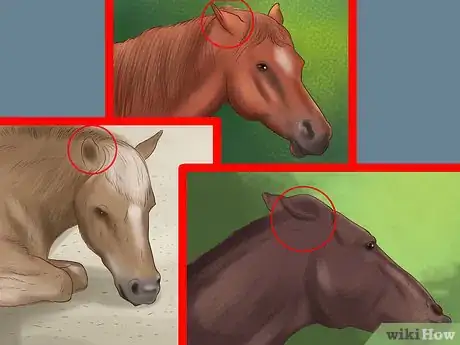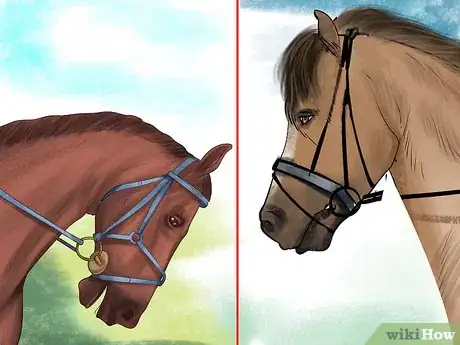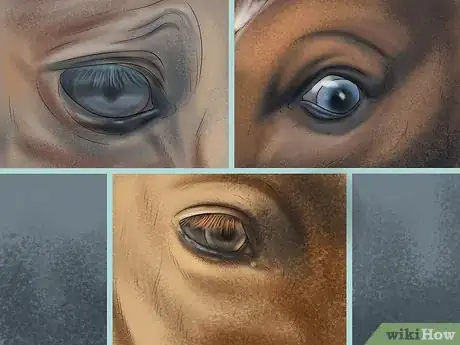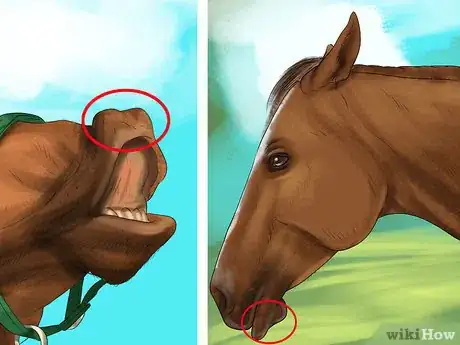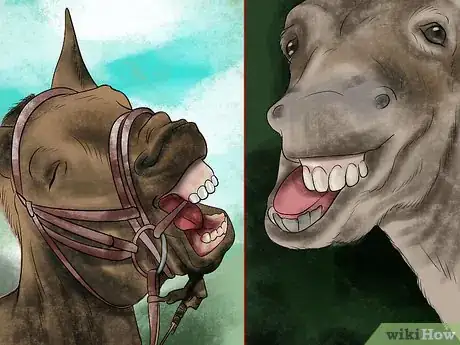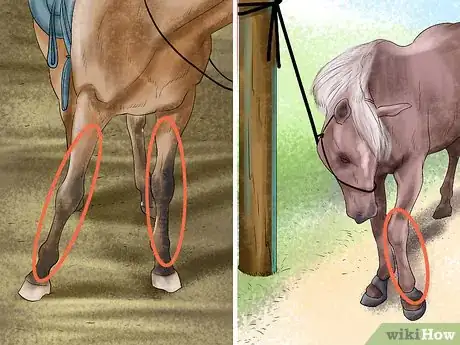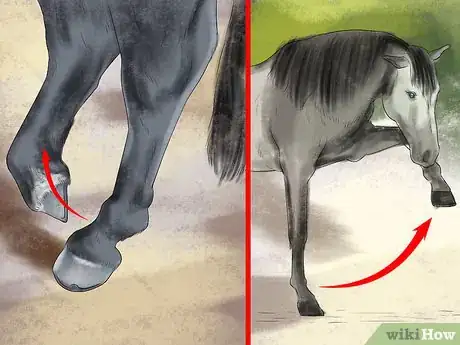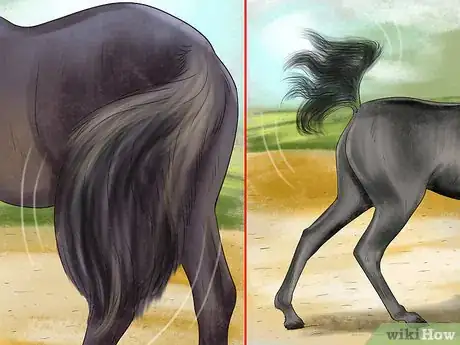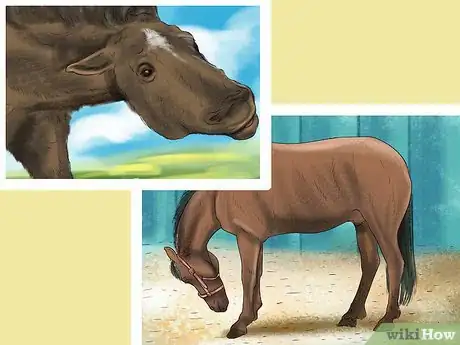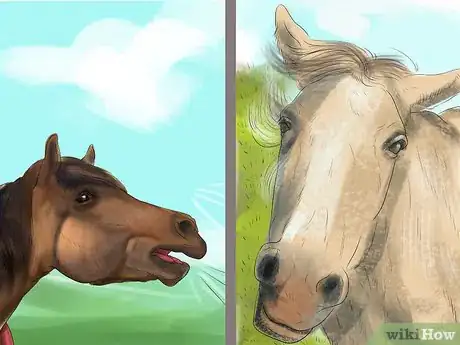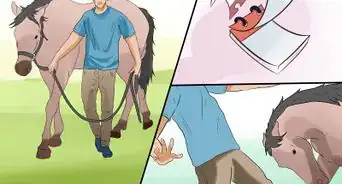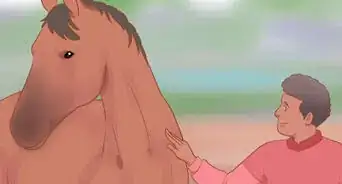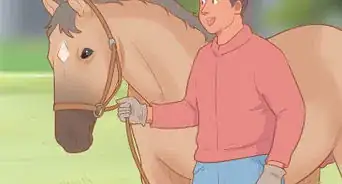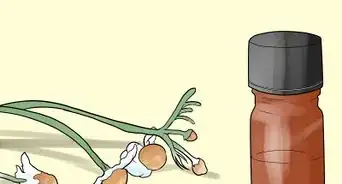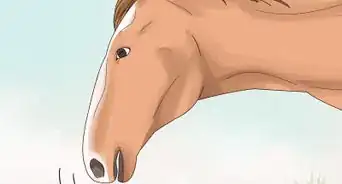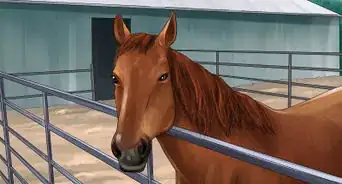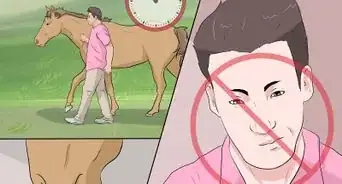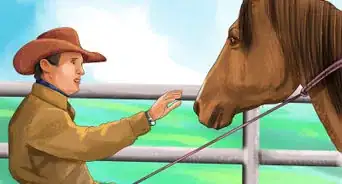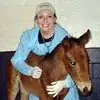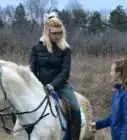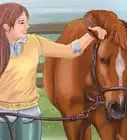This article was co-authored by Ryan Corrigan, LVT, VTS-EVN. Ryan Corrigan is a Licensed Veterinary Technician in California. She received her Bachelor of Science in Veterinary Technology from Purdue University in 2010. She is also a Member of the Academy of Equine Veterinary Nursing Technicians since 2011.
This article has been viewed 47,806 times.
Horses use body parts individually, as well as together, to communicate different things such as pain, anger, discomfort, excitement, or irritation. It's important to remember that horses are prey animals, so it's their instinct to choose flight in a fight or flight situation. When interpreting their body language, it's important to consider this instinct. By paying attention to the subtle movements of your horse’s body parts, you will be able to understand your horse and cater to its needs and insecurities.
Steps
Reading Your Horse from the Neck Up
-
1Read your horse’s ears. Horses use their ears in a variety of ways to communicate. Your horse’s ears can either be forward, pinned, turned out to the side, turned back, or rapidly swiveling. Here is a guide to figure out what each movement means:
- If your horse’s ears are positioned forward, this usually means your horse is relaxed. However, if they are sharply pricked forward this means your horse is alert and tuning into something that is either interesting or frightening.
- If your horse’s ears are pinned flat against the back of its neck, this means your horse is angry and aggressive.[1]
- If your horse’s ears are turned out to the side, this generally means your horse is relaxed or sleeping, and many not be attuned to what is going on around it. Be careful not to startle your horse when they are in this position. Instead, call their name or make a noise to rouse their attention.[2]
- If your horse’s ears are pointed backward, but not pinned, this means your horse is trying to listen to something behind it. When combined with swishing tail or other signs of tension in the body, ears that are turned back might be a precursor to pinned ears.[3]
- If your horse's ears are rapidly swiveling, i.e., flipping back and forth, this means your horse is in a heightened state of anxiety or alertness. Your horse may be trying to identify a frightening sound or smell.[4]
- When a horse is relaxed, their ears will point in the direction of what they are paying attention to. This means that a horse with its ears pointing backward may just be paying attention to what's going on behind it without being angry or aggressive.
-
2Read your horse’s head carriage. You can tell a lot about your horse’s mood by observing their head carriage. Your horse’s head carriage may be lowered, elevated, or snaking. Here is a guide to figure out what each position means:
- If your horse’s head carriage is lowered, this is a sign of relaxation or a sense of feeling good. Its ears will often hang to the side when its head is in this position. Also, if your horse is in the stall, a lowered head position might indicate that your horse is sleeping. Be careful not to startle your horse.[5]
- If your horse’s head carriage is elevated, the horse is in alert mode, and trying to decipher if it should flee, investigate, or ignore. To prevent your horse from bolting, try to regain its focus on you by saying its name.
- If your horse’s head carriage is snaking, i.e., lowering its head slightly and swinging it back and forth, this is an aggressive act. This is a red alert. Try to diffuse the situation by refocusing its attention, leaving the area, or getting away from the horse.[6]
Advertisement -
3Read your horse’s eyes. Your horse’s eyes indicate to you what your horse is thinking, as well as where its attention is focused. Your horse’s eyes may be relaxed, tense, darting rapidly, or your horse may be showing the whites of its eyes. Here’s a guide to understanding your horse’s eye movements:
- If your horse is relaxed, its eyelids will be relaxed where you will be unable to see the whites of its eyes.
- If see the muscles tighten around the eye, i.e., tightness around the corner of the eye or a wrinkled upper eyelid, this is an early sign of distress, fear, or discomfort.
- If you see your horse’s eyes darting rapidly, i.e., flicking from side to side, this means he/she is scared and looking for a way to escape. And, if your horse feels trapped, it might react by biting or kicking.[7]
- If your horse is showing the whites of its eyes, i.e., opening its eyes widely, it is only mildly alarmed or startled. However, in some breeds, like the Appaloosas and Pintos, the whites of the eyes are always visible. Therefore, it is only natural for the whites to show and it is not a sign of alarm.[8]
-
4Read your horse’s nose and lips. A horse’s nose and lips can communicate a lot about what it's feeling. Your horse’s nose and lips may be slack, curled, flaring, or tightly pinched or pursed. Here’s a guide to determine what each signal means:
- If your horse is standing quietly with its lower lip drooping, i.e., slack, it is relaxed and/or might be sleeping. Approach your horse with caution so as not to startle it. However, if your horse is awake and its lower lip is still slack, this may be a sign of a neurological problem. If this happens, you should take your horse to the veterinarian.[9]
- If your horse is curling its upper lip, also known as flehmen, it means that your horse is sniffing an unfamiliar smell. When a horse sniffs an unfamiliar smell, it raises its head, curls the upper lip, and breathes air through its mouth and back out through its nostrils.[10]
- If your horse is flaring its nostrils, it means one of two things. It is either out of breath and trying to draw in more air, or, if it is accompanied with a quivering, then your horse is either nervous or startled. Your horse's nostrils should only be flaring if it's been working. If your horse has not been working, then flaring nostrils could be a sign that something is wrong. You should call out a vet to check on your horse.
- If your horse’s nose and lips are tightly pinched or pursed (one of the more subtle gestures), then your horse is either worried, stressed, or scared. Try to diffuse the situation by moving your horse away from the area.
-
5Read your horse’s mouth and teeth. You can also understand what your horse is feeling by observing its mouth and teeth. Your horse’s mouth and teeth may be grinding, clacking, or gaping. Here’s a guide to determine what each signal means:
- Teeth grinding can be a sign of multiple things. Your horse could be stressed or experiencing pain or discomfort.
- Clacking teeth is usually a communication tool used by younger horses, or foals. If a younger horse is clacking its teeth, it usually means it is signaling to other horses that it is just a baby and does not want to be hurt.[11]
- A gaping mouth with visible teeth can mean several things. If your horse is showing its teeth combined with pinned ears and wide eyes, then it is displaying anger and might be seconds away from biting. If a horse is gaping while you are riding it, then the bridle and bit might be causing it pain. Finally, if your horse suddenly stops and opens its mouth with its neck stretched out while eating, it may be choking. Either try to remove the uneaten food or call a veterinarian immediately.
- Horses are nasal breathers, so they should only be breathing through their nostrils. If your horse is attempting to breathe through its mouth, then something is wrong. Call a vet immediately.
Understanding Leg and Tail Movements
-
1Read your horse’s fore legs. Your horses fore legs can be either splayed, pawing, stomping, or striking. Here is a guide to understanding your horse’s fore legs:
- If your horse’s fore legs are splayed, i.e., its fore legs are spread out to the sides and the horse is leaning back, then your horse is scared and may be seconds away from bolting. Splayed legs can also be a sign of malnutrition or a neurological impairment, especially if the horse is unwilling to or cannot move. Call a veterinarian.
- If your horse is tied up, pawing, i.e., an arcing fore leg that is digging a trench in soft ground, may be a sign of boredom and a signal that your horse is either tired of standing or ready to go. Stressed horses may paw if they are in a trailer or before feeding time. Horses may also paw of they are angry, but it is not common. However, if it is combined with pinned ears, then it is a signal that you need to heed. It is a sign of anger or aggression, and charging or some kind of attack, like biting, usually follows it.[12] Some horses develop pawing as a bad behavior to get attention. Knowing your horse's normal behavior can help you figure out if this is why your horse is pawing.
- If your horse is stomping, i.e., raising and lowering a foot forcefully in place, this is a common sign of irritation. It could be something minor, like a fly, or something bigger, like your horse is frustrated with something you are doing.
- If your horse is striking its fore legs, i.e., a forceful and aggressive forward kick, this is a sure sign of anger or aggression. It is usually preceded by stomping or pawing, wide eyes, and an elevated head with pinned ears. Take caution if this happens.
-
2Read your horse’s hind legs. A horse’s hind legs can be either cocked or raised. Learn how to determine the different signals by following this guide:
- Cocked legs may either signal resting, pain, or irritation. Your horse is relaxing if it rests the leading edge of the hoof on the ground and drops its hip; this is usually combined with a lowered head and ears hanging to the sides. Your horse is in pain if it shifts its weight from one side to another rapidly. On the other hand, if your horse is frustrated and/or defensive, it will cock its hind leg, elevate its head, and cock or pin its ears back.
- If your horse raises its hind leg, cocks and pins its ear back, and/or sways its head, this is a sign that it is frustrated and bothered and ready to kick.[13]
-
3Read your horse’s tail. The tail is one of the more mobile signs of communication. Your horse can raise or flag its tail, clamp it down, or swish it rapidly. Here’s a guide to know what each signal means:
- A raised or flagged tail means your horse is excited. This is a tail that is held above the level of the back. A horse with a flagged tail isn’t usually paying much attention to you, and is prone to being startled. Regain your horse's attention by calling its name and putting it to work.
- A clamped tail, i.e., the tail is pressed down or in between its hindquarters, is a sign of a nervous or stressed horse. Additionally, if your horse clamps its tail while you are riding it, this is a sign of discomfort or pain. Make sure your horse’s tack fits well. If the movement persists, contact a veterinarian.
- If your horse is gently swishing its tail, this is just a sign of fly control. However, if your horse is quickly jerking its tail from side to side or up and down, this is a sign of anger and frustration, and a precursor to bucking or kicking. On the other hand, if your horse is frequently swishing its tail while you are riding, this can be a sign of discomfort; make sure the tack is properly fitted and no sharp or protruding edges are hurting it.
Recognizing Other Signals
-
1Read your horse’s body tension. By reading your horse’s body tension, you will be able to tell if your horse is relaxed, stressed, nervous, or scared. Here’s a guide to understanding these behaviors:
- If your horse’s muscles are rigid and its movements are stiff, it is either nervous, hurting or stressed. Assess the situation to figure out what is causing your horse to be tensed, and remove your horse from the situation.
- If your horse is trembling, i.e., its whole body is shaking, this is a sign of fear.
-
2Heed the warning signs. By heeding warning signs, like pushy behavior or swinging hindquarters, you will be able to create a space that is safe and comfortable for you and your horse. Here is a guide to understanding these warning signs:[14]
- If your horse is reaching out to touch you with its muzzle, it might be about to bite you. Or, it could also just be interested in you. Your horse could also be nervous, and might be reaching out to you for reassurance. However, if your horse pushes you with its muzzle, this is a sign that it does not respect you because you have not established that you are a leader. Horses are herd animals that are used to hierarchy and structure. You need to establish dominance so your horse does not push you around. [15]
- If your horse is swinging its hindquarters from side to side, it can be a warning sign that it is about to kick. However, if swinging hindquarters is associated with a raising of the tail while moving it back and forth, and urinating, and the horse is female, then it is most likely a sign of being in heat.
-
3Recognize horse vocalizations. There are four primary signs of horse vocalization. They are: neighs and whinnies, nickers, squeals, and snorts. Here is a guide to determine what each of them means:
- When a horse neighs or whinnies, the horse is announcing that it is present. It also neighs to acknowledge other horses in the vicinity.
- Nickers, or softy throaty sounds, are often used by a mare to encourage her baby, i.e. a foal, to eat.
- Squeals are often used as a threat display and might happen if you introduce two horses to each other.
- Horses use snorts to signal danger or to alarm other horses that a strange animal has come too close for comfort.
-
4Put it all together. To figure out what your horse is trying to tell you through its body language, you need to put all of the pieces together. Consider all of your observations and what they might mean when taken together.
- For example, if your horse is showing stress through both its ears and legs, then you can conclude that it is stressed.
- Knowing your horse's personality and normal behavior will help you figure out if the behavior is typical for your horse or if your horse is trying to give you a message.
-
5Ask for help. Don't be afraid to ask for help or advice, especially if you are new to horses. Ask someone who has grown up around horses or an equine expert, who can teach you what you need to know about horses.
Expert Q&A
-
QuestionWhy would a horse rear up?
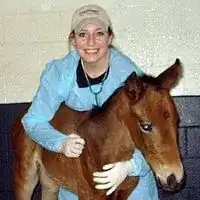 Ryan Corrigan, LVT, VTS-EVNRyan Corrigan is a Licensed Veterinary Technician in California. She received her Bachelor of Science in Veterinary Technology from Purdue University in 2010. She is also a Member of the Academy of Equine Veterinary Nursing Technicians since 2011.
Ryan Corrigan, LVT, VTS-EVNRyan Corrigan is a Licensed Veterinary Technician in California. She received her Bachelor of Science in Veterinary Technology from Purdue University in 2010. She is also a Member of the Academy of Equine Veterinary Nursing Technicians since 2011.
Licensed Veterinary Technician Typically rearing is a fear response to put distance between the horse and whatever it fears.
Typically rearing is a fear response to put distance between the horse and whatever it fears. -
QuestionCan horses sense when you are afraid of them?
 Ryan Corrigan, LVT, VTS-EVNRyan Corrigan is a Licensed Veterinary Technician in California. She received her Bachelor of Science in Veterinary Technology from Purdue University in 2010. She is also a Member of the Academy of Equine Veterinary Nursing Technicians since 2011.
Ryan Corrigan, LVT, VTS-EVNRyan Corrigan is a Licensed Veterinary Technician in California. She received her Bachelor of Science in Veterinary Technology from Purdue University in 2010. She is also a Member of the Academy of Equine Veterinary Nursing Technicians since 2011.
Licensed Veterinary Technician Yes, horses pick up on your movement, body language, and how you're feeling.
Yes, horses pick up on your movement, body language, and how you're feeling. -
QuestionWhy does a horse paw at the ground?
 Ryan Corrigan, LVT, VTS-EVNRyan Corrigan is a Licensed Veterinary Technician in California. She received her Bachelor of Science in Veterinary Technology from Purdue University in 2010. She is also a Member of the Academy of Equine Veterinary Nursing Technicians since 2011.
Ryan Corrigan, LVT, VTS-EVNRyan Corrigan is a Licensed Veterinary Technician in California. She received her Bachelor of Science in Veterinary Technology from Purdue University in 2010. She is also a Member of the Academy of Equine Veterinary Nursing Technicians since 2011.
Licensed Veterinary Technician Horses can paw to show pain or discomfort, they sometimes paw when they're bored or frustrated, and sometimes when they want food!
Horses can paw to show pain or discomfort, they sometimes paw when they're bored or frustrated, and sometimes when they want food!
References
- ↑ http://articles.extension.org/pages/15174/basics-of-equine-behavior
- ↑ http://equusmagazine.com/article/how-to-read-your-horses-body-language-8577
- ↑ http://equusmagazine.com/article/how-to-read-your-horses-body-language-8577
- ↑ http://equusmagazine.com/article/how-to-read-your-horses-body-language-8577
- ↑ http://equusmagazine.com/article/how-to-read-your-horses-body-language-8577
- ↑ http://equusmagazine.com/article/how-to-read-your-horses-body-language-8577
- ↑ http://equusmagazine.com/article/how-to-read-your-horses-body-language-8577
- ↑ http://equusmagazine.com/article/how-to-read-your-horses-body-language-8577
- ↑ http://equusmagazine.com/article/how-to-read-your-horses-body-language-8577
- ↑ http://equusmagazine.com/article/how-to-read-your-horses-body-language-8577
- ↑ http://equusmagazine.com/article/how-to-read-your-horses-body-language-8577
- ↑ http://equusmagazine.com/article/how-to-read-your-horses-body-language-8577
- ↑ http://equusmagazine.com/article/how-to-read-your-horses-body-language-8577
- ↑ http://articles.extension.org/pages/15174/basics-of-equine-behavior
- ↑ http://articles.extension.org/pages/15174/basics-of-equine-behavior
About This Article
To understand your horse's body language, start by monitoring its ear movements. For example, if its ears are positioned forward, your horse is probably relaxed, and if they're pinned flat against the back of its neck, your horse may be angry or feeling aggressive. Nose movements, like nostril flaring, can indicate nervousness or surprise, and if the nose and lips are tightly pinched together, your horse might be stressed or upset. Also, if your horse raises its tail, it's probably excited, and if it presses its tail down between its hindquarters, it may be nervous or stressed. For tips on understanding your horse's leg movements, read on!
